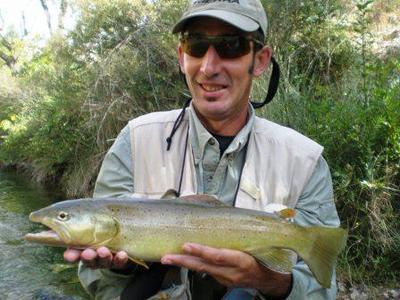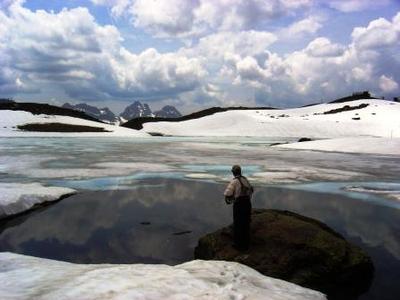FLIES
Insects hatch in abundance from April to September and the variety of species is enormous due to the high quality of the water. The most widely used and successful flies include:
Mayflies & caddis n 12-18
Stoneflies, flat & cad. Nymphs n 8-14
It is important not to forget:
Attractors n 12-16
Varied terrestrial n 8-12
Streamers in natural colours n 6-8
Once your reservation is complete we will be happy to provide you with a complete study of the natural flies for each month.
RODS AND LINES
For dry-fly fishing on rivers we suggest rods be 8 to 9 feet and of between 3 to 4 in gauge. Floating line. 8 to 10 foot trailers with a final tippet of 5X to 7X.
For lake fishing we recommend a 9' or 9' 6" rod of between 5 to 6 in gauge, floating WF line, 10 to 12 foot trailers and a taper of 2X to 5X.
GUIDING SERVICES IN THE AREA
In Santa Cilia de Jaca , between Navarra and Aragonese Pyrenees and in Aren, between Catalonia and Aragonese Pyrenees there are two Lodges from a recognize Guiding services Company called SALVELINUS, who offer complete fly fishing services organizing daily and weekly programs with helicopter fly-outs and activities for the non angler.
www.salvelinus.com
THE FISHING SEASON IN THE PYRENEES
There are many different restrictions in the different regions, areas and valleys but we could find open water to practise wild trout fishing along:
General
19th March 15th September Western Pyrenees
1st March 30th of November Eastern Pyrenees
High Mountain
1st of June 15th of September Western Pyrenees
15th of May 30th of September Eastern Pyrenees
* April May: could be a good option in some lower reaches
* June-July and September: prime time for Dry-Fly Fishing
* August: the best temperature for High Mountain Fishing
* October November: best conditions for the biggest ones
Winter Fishing a few "cotos de pesca" are opened
FISHERY MANAGEMENT
The regional administration is responsible for fisheries management. It is necessary to have a regional (Aragon, Navarra or Catalu a) fishing licence (there is no national fishing licence in Spain).
There are "cotos de pesca": these fishing betas are between 3 km to 30 km long. Inside these areas is necessary to have a personal day permit in addition to the regional licence.
Legislation is very strict and catch and release is compulsory in most areas although you could find very hidden free areas you are able to kill but where nobody go , and finally full of trout.
CLIMATE
The southern face of the Pyrenean range, our area, has a very favourable climate.
The average temperature along the season is around 60-80 Fahrenheit but you can not remember you are in Pyrenees Mountains and in the same hour could be a different of 30 degrees between lower reaches and high mountain. The weather in high mountain could be hard in any season.
In winter snow covers the majority of the trout valleys.
FAUNA & FLORA
The Aragonese Pyrenees has many protected natural areas covering approximately 8% of the region. There are also 200,000 hectares of hunting grounds.
There are many species of wild animals, reptiles and birds in the Pyrenees from brown bears to fire salamanders. Egyptian, griffon and bearded vulture, golden eagle, dipper, wild boar, sarrio (similar to chamois), mountain goat, eagle owl and red squirrel are all frequent sights to accompany a day's fishing. There is also the possibility of spotting the elusive Pyrenean Desman in the higher mountains streams.


